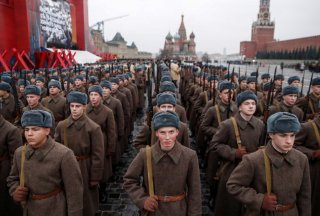The Soviet Red Army Used Reindeer to Help Defeat the Nazis
The Soviets' reindeer may not have been able to fly, but a group of reindeer as a team could haul even artillery pieces and ammunition and could travel twenty miles in under eight hours.
It may be Santa's reindeer that the North American Aerospace Defense Command (NORAD) will track on Christmas Eve as he travels the world to deliver presents to good little boys and girls. But during the Second World War, the animals weren't used to pull a flying sleigh and instead helped transport material from the port of Murmansk in Northern Russia to the battlefront. In 2012, a war memorial in the Arctic Russian town of Naryan-Mar was commissioned to recognize the contribution and sacrifice of the reindeer-based military transport battalion.
About 1,000 indigenous reindeer herders, many from the Saami tribes in the Kola Peninsula but also from across the Russian Arctic region, along with more than 10,000 of their reindeer, were pressed into service and were used to transport the material—which was offloaded from Lend Lease convoys in Murmansk—and brought to the Karelian Front between 1941 and 1944.
"The majority of ground combat in Europe among the Axis—and certainly the Soviets—was done with infantry on the ground using horses and donkeys," U.S. Naval Historian Tim Francis told NPR in a 2011 interview about the history of the Reindeer Battalion. "And in the north, it would be reindeer."
The fact that 1,000 men had been available to herd the animals as beasts of burden may come as a surprise given that the Red Army's conscription program had called upon practically every able-bodied man, while many women were also fighting at the front, especially during the desperate times after the German invasion that drove deep into the Soviet Union.
Winter War and World War II
That changed during the Winter War of 1939-40 with Finland when the Soviets needed personnel who understood the harsh terrain and how to deal with it. After Germany invaded in 1941 and the only way to get material from the Allies was via the northern ports, the Soviets conscripted the herders and their animals.
Reindeer were able to survive in the harsh cold winter weather, but they could also pull an incredible amount of weight. The Soviets' reindeer may not have been able to fly, but a group of reindeer as a team could haul even artillery pieces and ammunition and could travel twenty miles in under eight hours.
The first three Red Army reindeer transport groups—dubbed the "raida"—were assembled in 1941 as the Soviets fended off the Germans on the Karelian front. The Reindeer Battalion originally numbered just 1,015 animals and 77 herders, but by 1942 their ranks reportedly swelled to include some 1,477 men, 11,015 reindeer, and even fifteen dogs divided into five battalions of the 14th Army.
Rough Start
The first batch of men and beasts had to travel more than 1,200 miles by train and foot. Despite being hearty animals, the reindeer could only travel thirty miles a day and needed to rest every four days. In addition, unlike horses or even camels, reindeer weren't particularly well suited to trains and many became sick and hungry.
The herders didn't fare much better. Many clashed with their officers—and there was mutual distrust and a deep dislike of one another. Tensions ran so high that some of the conscripted herders were threatened with violence. However, a few officers took an interest in the indigenous people and even attempted to learn their language. Those men became a vital link in the chain.
The reindeer and the herders proved invaluable, especially during the Petsamo-Kirkenese Offensive in early 1944. The animals allowed material to be moved quickly and proved superior to Russian horses and even armored cars. The reindeer didn't get bogged down in deep snow, and they seemed unperturbed by the sounds of exploding shells.
As the Germans were pushed back, the Reindeer Battalion was no longer needed and was demobilized.
The herders refused to use the trains, and instead set out for home on foot, and it took as long as eight months for some to make it to the more remote parts of Northern Russia. Many of the reindeer were left behind and mixed with the local reindeer population. The descendants of those wartime reindeer are still prevalent in the region today, and the Pasvik River Valley even weigh twice as much as other reindeer in the region.
Peter Suciu is a Michigan-based writer who has contributed to more than four dozen magazines, newspapers, and websites. He regularly writes about military small arms and is the author of several books on military headgear including A Gallery of Military Headdress, which is available on Amazon.com.
Image: Reddit

